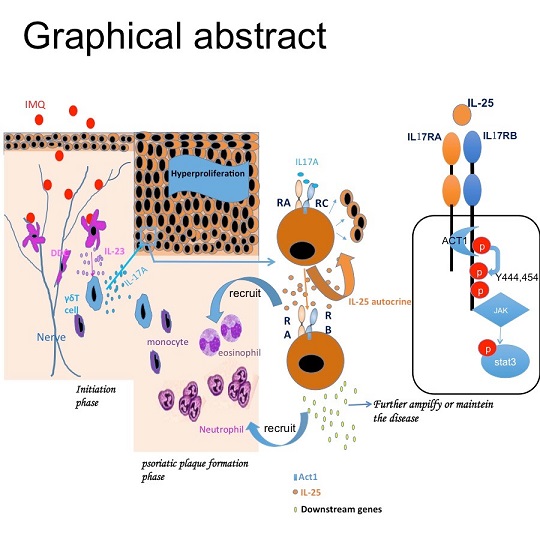On April 10, 2018, Prof. Chen Dong’s research group in school of Medicine, Tsinghua University published a paper in Immunity, entitled “An interleukin-25-mediated autoregulatory circuit in keratinocytes plays a pivotal role in psoriatic skin inflammation“,revealing the function and mechanism of interleukin-25 (IL-25) in psoriasis development.

Psoriasis is a chronic autoinflammatory skin disease, affecting approximately 2% global population. Although IL-17, derived from lymphocytes, has been shown critical in psoriasis and the drug designed by targeting IL-17A is effective, the initiation and maintenance of chronic skin inflammation has not been understood. IL-25/IL-17E, another IL-17 family cytokine, is well known to regulate allergic responses and type 2 immunity, but little was known about its function in other autoimmune diseases.
In this work, Prof. Chen Dong’s research group found that IL-25, also highly expressed in lesional skin of psoriasis patients, was regulated by IL-17 in murine skin of imiquimod(IMQ)-induced psoriasis model. IL-25 injection induced skin inflammation, including acanthosis, dermal swelling and immune cells infiltration. Germline or keratinocyte-specific deletion of IL-25 caused resistance to IMQ-induced psoriasis. Via IL-17RB expressed in keratinocytes, IL-25 stimulated the proliferation of keratinocytes and induced the production of inflammatory cytokines and chemokines, via activation of STAT3. Further, Chen Dong’s group found that IL-25 can promote its receptor IL17RB tyrosine phosphorylation to directly bind to STAT3, which mediated the downstream responses. These results demonstrated an autoregulatory circuit in keratinocytes mediated by IL-25, which may be targeted in treatment of psoriasis patients.
Professor Chen Dong is the corresponding author of the paper. Miao Xu from School of Life Sciences, Tsinghua University is the first author of the paper. Other collaborators include researchers from Tsinghua University, East China Normal University and Shanghai Tenth People’s Hospital, Tongji University. This work was supported by grants from Ministry of Science and Technology, National Natural Science Foundation of China and Beijing Natural Science foundation.
The original link:
http://www.cell.com/immunity/fulltext/S1074-7613(18)30116-X